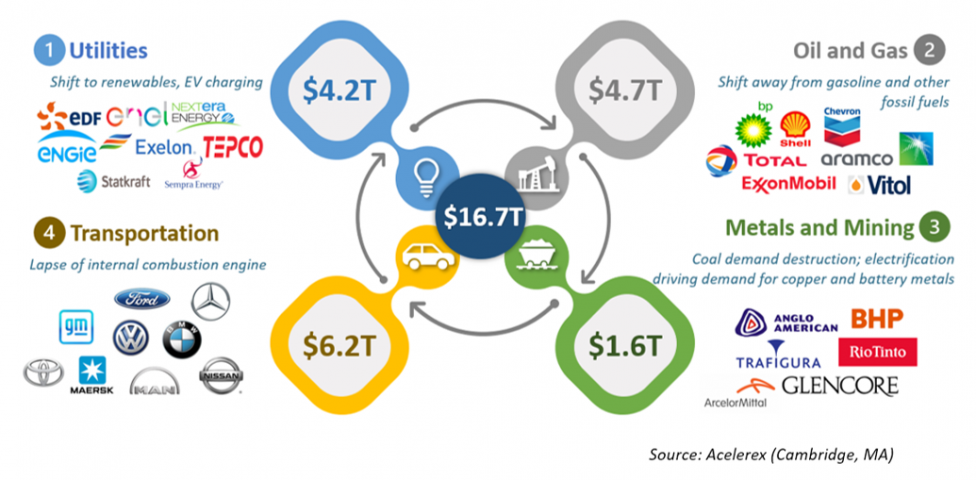Electrification is poised to be the single greatest global megatrend of the 2020s.
As this megatrend unfolds, the “eye of the storm” through the 2020s will be the power grid. The stress that electrification will place on the power grid — despite incremental augmentation, it still largely runs on an architecture designed in the 1920s — will necessarily pressure it into rapidly assimilating the 21st century digital technologies which have disrupted other sectors: AI, IoT devices, blockchain, big data, data mining, cloud computing and real time optimization algorithms.
Mainstream recognition of this megatrend is only beginning to emerge, with the sheer reach of the disruption of the power grid still something which the market is yet trying to comprehend.
Acelerex attempted to sketch out the broad outlines of electrification and the disruption of the power grid (see attached chart). The rough numbers are staggering. The future trajectory of four of the largest sectors of the world’s “old economy” are intimately tied to the disruption of the power grid: Utilities, Oil & Gas, Metals & Mining and Automotive.
The total annual economic output of these four sectors is a massive $17 trillion. That equates to roughly 20% of global GDP.
A Multi-Sector Turf War for the 21st Century Power Grid
Electrification is kicking off a turf war between Utilities, Oil & Gas and Automotive companies, with the Digital Grid at the very center of that turf war. For Utilities and Automotive companies — sectors long constrained in seeking out fresh pathways to growth — electrification opens up the Digital Grid as a massive, high-growth new business model. For Oil & Gas companies, the Digital Grid becomes territory which must be conquered simply to hedge against an erosion of their core businesses.
The picture is less stark for Metals & Mining companies, who are a step removed from direct impact from the power grid. However, they have still had to reorient their strategies away from the metals that fueled the emerging markets megatrend between 2001 and 2016 (e.g. iron ore, aluminum) towards the metals that are in demand for the electrification megatrend of the 2020s (e.g. lithium, nickel and cobalt).
Will Silicon Valley Emerge as the Natural Owner of the 21st Century Grid?
The types of names — behemoths of the late 19th and early 20th century industrial economies — who are set to be impacted by electrification and the disruption of the power grid are no less startling: General Motors, ExxonMobil, BP, BHP, Rio Tinto, Total, EDF and so on. Eventually, as the power grid of the 21st Century becomes more of a reality, these “old economy” behemoths will find increased competition from the Silicon Valley behemoths who will see the Digital Grid as belonging to their own domain: the likes of Google, Microsoft, Amazon and Oracle, among others.
Until now, the market at large has been motivated to seek out the visible turf wars (hardware, OEMs, infrastructure) catalyzed by electrification. As reliability and resiliency issues such as the ones faced recently in Texas and Britain demonstrate, the most intriguing turf war catalyzed by electrification may very well be over a less visible but critical sector: the power grid itself.

